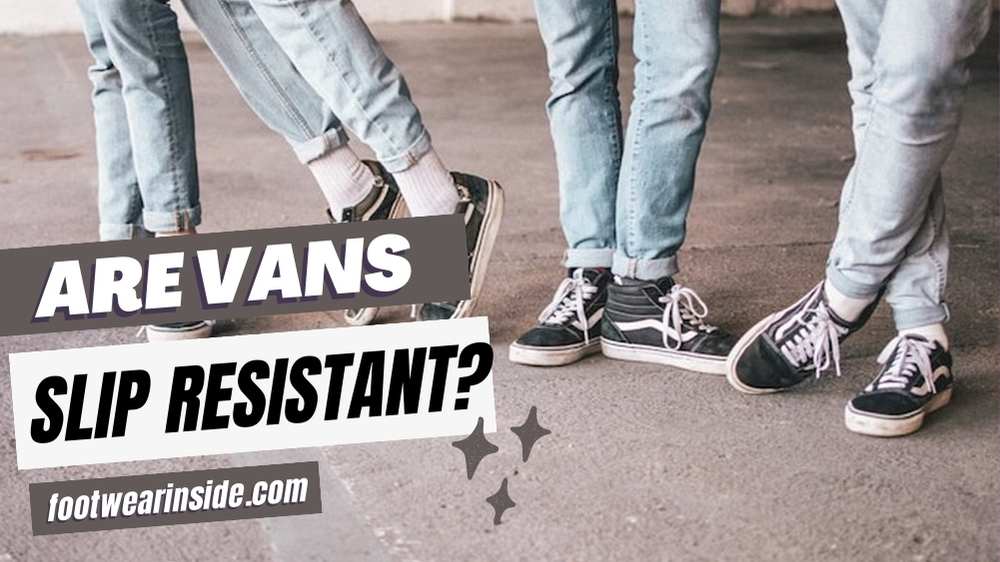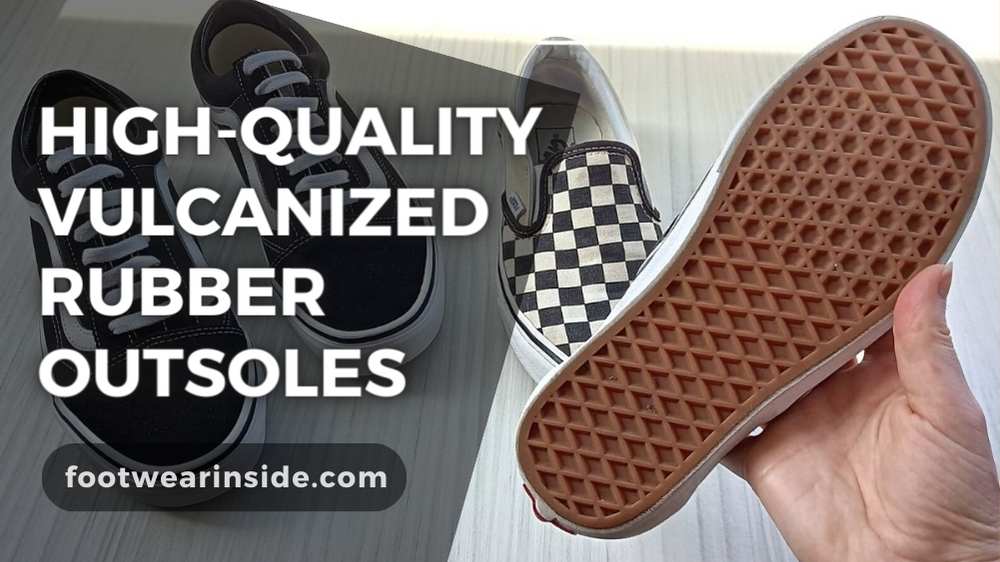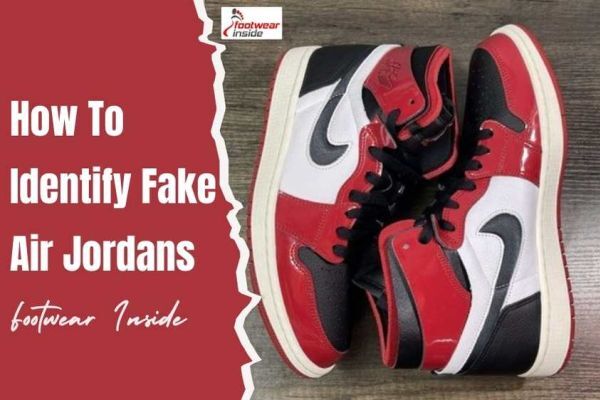YES! Vans are slip resistant. Because of their premium rubber material and vulcanized rubber outsoles with diamond and rhomboid patterns, Vans shoes are slip-resistant. They are a safe choice for various activities because they provide maximum grip and stability in any environment.

As suggested by the men hero, and because the outsoles of all Vans are made of rubber, we can safely say that they are all slip-resistant. We have read product descriptions for over fifty pairs of Vans shoes and have yet to see any mention that they are slip resistant. Rubber, impervious to moisture and cold, is used instead for the outsoles in Vans.
Vans shoes provide optimal friction for ground grip but may not be the best for running. They’re safe for walking and other activities that involve slipping because their tread patterns increase traction, and their soles don’t retain water.
What Features Make Vans Slip Resistant?
Vans started as a skate shoe company. However, because of their adaptability, Vans shoes are comfortable popular in various settings, from eateries to fitness centers to casual strolls down the street.

Wearduke says that Vans shoes have a waffle-shaped pattern on the outsole to provide a secure grip on the skateboard’s surface. Similarly, Vans are great for maintaining a secure footing on hard, flat surfaces like hardwood or tile.
Vans gum rubber is heated during vulcanization to increase its durability and bond with the upper. Slip resistance depends on the sole tread pattern. Vans’ Made for Maker collection’s waffle pattern and small protruding lugs make the soles slip-resistant.
As mentioned above, we can summarize the features: High-Quality Vulcanized Rubber Outsoles & Nonslip Tread Patterns.
High-Quality Vulcanized Rubber Outsoles
Vans shoes are made of durable synthetic rubber that provides a good grip. Before vulcanizing, the rubber is heated and compressed, causing it to harden and increase its tensile strength. Due to this treatment, vans shoes are highly durable and resistant to wear and tear.

Vans shoes are made with vulcanized rubber, which has excellent resilience, low water absorption, high resistance to oxidation and abrasion, good electrical insulation, and resistance to organic solvents. Vans use rigid materials like canvas and suede for the shoe uppers, which can withstand the high temperatures generated during vulcanization.
Non Slip Tread Patterns
Thedashingmen claim that the tread pattern on Vans’ shoes is another vital safety feature. Tread patterns can be found on the soles of most shoes. However, Vans shoes are not like any other slip-resistant footwear. So you must know that are Vans bad for your feet or not?
Why do vans have a variety of sole patterns, each designed to withstand the unique stresses experienced by a specific area of the foot? It simply increases the shoe’s slip resistance by minimizing the grease and water that can adhere to the sole.
How to test Vans Shoes’ Slip-Resistance?
The slip-resistant label is helpful when selecting work or walking footwear. However, this does not guarantee that your shoe is slip-proof. We feel more confident wearing shoes like Crocs and Dansko Clogs, marked as slip-resistant, on floors that may be slick from spills or other accidents.

However, you won’t find a slip-resistance label on Vans or other athletic shoe brands.
Here are Asjad Aamir’s Five Ways to Test Vans Shoes’ slip-resistance.
- Inspect the Sole Content: The soles of your shoes should be made of a nonslip material like thick rubber. However, the rubber shouldn’t be too soft, or it won’t be able to distribute pressure evenly, which is essential for grip. Shoes with a rubber sole are the best option.
- Find a Tread Pattern: The soles of your shoes are one of the essential safety features in avoiding falls. You want a tread pattern with shapes like squares, hexagons, triangles, and circles, as opposed to a smooth tread, which will provide little grip. The circle-grip outsole is the most effective of these designs.
- Inspect the Roughness of the Tyres: Check your shoes’ tread depth to ensure they are pretty enough. The slip-resistance of the shoe will be diminished if trash and debris can wedge themselves in between the pattern. Choose a tread pattern with more depth or wider gaps between the studs.
- Avoid Wearing Bulky Lugs: Large, thick lugs may look great, but they offer little grip on smooth floors. The soles of these shoes are better suited to walking on rough ground. Avoid shoes with deep lugs if you’ll be doing most of your walking on smooth pavement.
- Determine Oil Resistance: “Oil-resistant shoes” and “slip-resistant shoes” are not interchangeable. While oil-resistant footwear protects its wearer from oil spills, it may be unsafe to wear in wet conditions. Look for shoes with oil and slip resistance if walking on oily floors.
How To Make Vans Even More Non-Slip?
Vans are great for long days at the office and other activities like snowboarding and skateboarding. Their traction and grip are sufficient. In environments that demand slip-resistant footwear, you can follow some simple steps to improve their traction.

The following are some simple steps that can be taken to improve the traction of your Vans shoes:
- Attach Nonslip Soles or Pads: You can have a cobbler or a shoe store attach nonslip soles to your Vans, or you can add nonslip pads to the soles that are already on your Vans. When working on wet surfaces or mopping floors, this is especially helpful.
- Sand or Scuff the Soles: To make the soles of your shoes more rugged, you can either sand them or scuff them on surfaces like cement. Your Vans will have better traction as a result, and they will be less slippery.
- Use a Spray That Prevents Slipping: Applying a slip-resistant traction spray to your Vans before each use can add an adhesive layer to the soles, improving the shoes’ grip and slip resistance.
- Attach Ice Grips: To improve your grip in icy or snowy conditions, attach ice grips to the outsoles of your Vans and secure them with a nut and bolt.
However, that’s not the end of it! The following are some additional tips that will help you to increase the slip resistance of any pair of shoes:
- Add some texture to the soles of the shoes by using acrylic paint, sandpaper, a nail filer, or hairspray to prevent slipping.
- Combine PVC glue and salt, and then apply the resulting mixture to the soles of the shoes to increase their traction.
Avoid putting your activities or your job at risk by walking on any surfaces that could be slick. Use these simple tips to improve the safety of your Vans footwear.
FAQs
Are Old Skool Vans Non Slip?
Yes, old Skool Vans do not get slippery. Many customers are inquisitive about these Vans because they are the most sought-after models. Slip resistance is exceptional in Vans shoes, with the signature Vans waffle sole crafted from gum rubber. The sole’s resistance to slipping ensures superb grip and support across various surfaces.
Are Checkered Vans Nonslip?
Vulcanized rubber outsoles ensure that your checkered Vans won’t slide around. The soles are designed with a waffle pattern for superior traction. Checkered Vans, like regular Vans, have good grip and traction but aren’t made to be nonslip shoes.
Are Vans Nonslip For Restaurants?
If you’re wearing nonslip vans, the immediate answer is yes. Many different options are both secure and comfortable to wear every day. Many people find them a suitable choice when shopping for safety footwear. The good news is that virtually every pair of new Vans will have a sole designed to prevent slipping.
Are Vans Nonslip Shoes For Work?
Vans are an excellent option for professionals who spend most of their standing or walking, such as waiters, baristas, janitors, stylists, and others who work in environments with wet floors. People who work in kitchens are often seen wearing Vans. Still, those who work in hospitals, petrol stations, and other similar environments also benefit from having a reliable pair of slip-resistant footwear.
Are Vans Slip-Resistant Shoes Good for Running?
The short answer is no; vans are not suitable for running. The soles are skinny and flat. This means that there is little cushioning and arch support. You will strain your joints and ligaments if you try to run in them for long distances or on hard surfaces.
Are Vans Grippy?
Because of their thick rubber soles and tread patterns, Vans shoes are typically very grippy and offer excellent traction. However, they must be constructed with the traction needed for specific occupations or recreational pursuits.
Final Words
Do you enjoy wearing Vans shoes while skateboarding or snowboarding? I sure do. Your Vans shoes can provide the slip resistance you require with the right hacks. Here, you have learned that Vans are Slip resistant, and why? Moreover, you learned how to test Vans shoes slip-resistant.
So, now you are free to maneuver as you like with your Vans. Don’t let slippery surfaces keep you from your favorite activities. Don’t worry—hacks can make them slip-resistant. Use these tricks to get creative and tackle any challenge.



![How To Identify Nike Shoe Model [Easy Ways]](https://footwearinside.com/wp-content/uploads/2023/07/How-To-Identify-Nike-Shoe-Model-Easy-Ways.jpg)
